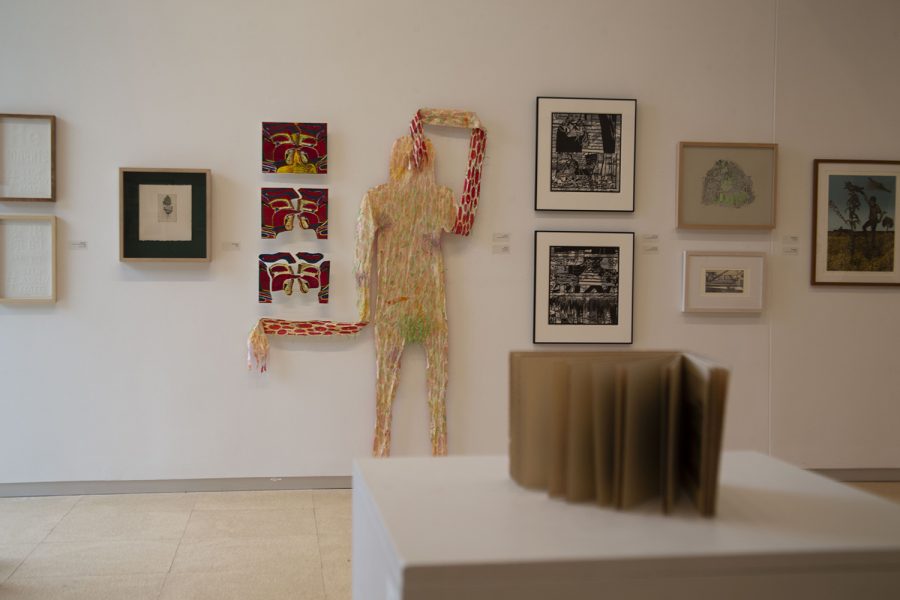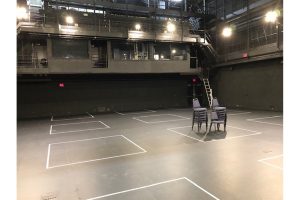Printmaking exhibition hosts pieces by 50 artists
For the last month, the Mid America Print Council Members’ Exhibition has displayed printmaking pieces from artists around the country, including some UI alumni.
Mid America Print 2021 Members’ Juried Exhibition is seen on Oct. 15, 2021. This exhibit is showcased from Oct. 3, to Nov. 7, and is held at the University of Iowa’s School of Art and Art History.
November 3, 2021
The University of Iowa is home to one of the first printmaking programs in the country, making it a prime destination for the Mid America Print Council Members’ Juried Exhibition.
The Mid America Print Council (MAPC), a printmaking organization that puts on a juried members exhibition every year, selected the UI as this year’s host. For the past month, the Visual Arts Building’s Eve Drewelowe Gallery has been filled with the innovative works of over 50 artists — many of whom graduated from the UI.
Juried by artists Mildred Beltré and Jennifer Hughes, winners of the exhibition received the Elizabeth Catlett Memorial award.
Heather Parrish, assistant professor of printmaking in the School of Art and Art History, said the exhibition includes a variety of media. There are etchings, relief prints, and lithography among the many styles of printmaking represented.
“It’s representing a lot of different artists that are in different stages of their careers,” Parrish said. “Some of them are students or recently graduated, so it’s a really nice range of representation.”
Terry Conrad, also a UI assistant professor of printmaking, said that printmaking is like working from a matrix. Artists start with a material, like a piece of wood or metal, then transfer their work onto many kinds of substrates.
He has used the exhibition as a teaching opportunity within his classes. Conrad had his students create presentations on all the artists, so he and his class have been able to experience the work daily.
“I find the community of printmaking really important,” Conrad said. “The fact that there’s an organization in America where we can connect is a big deal.”
Any member of the MAPC could apply, and the majority submitted three to five works. Parrish said that the jurors try to limit it to 60 entries based on the size of the gallery. She called this year’s exhibit an “overflowing show” because of the amount of wonderful work that was chosen.
Alex Fox, who graduated from the UI last spring with a printmaking degree, received the first-place prize for his piece “Ecdysis Remains.”
RELATED: UI printmaking fellow Elena Smyrniotis’s vision of ice
He was inspired to create the piece after thinking about how — if he were to shed his skin like a snake and stick it to the wall – what would it look like?
“Later on, it became a kind of metaphor for shedding my old self behind but still acknowledging it,” Fox said.
To design the print, Fox had to analyze himself first. He chose green yarn to cover the body with “hair” since his hair was dyed green at the time. He said people would always comment on how long his arms were when he walked, so the body has extra-long and dragging arms.
“It was poking fun at myself, but still having a little bit of seriousness to it,” Fox said. “That’s who I was at that point in time, but that’s not who I am anymore.”
When Fox found out the MAPC Exhibition was going to be held at UI, he thought it was the perfect time to apply. This was his first group exhibition outside of school, and though he didn’t expect to win anything, receiving first place was validating.
“It’s like one of the highest points in my career so far, and I’m still a young artist,” Fox said. “I was really impressed with the whole show in general. So, to be recognized among such a talented group of artists is amazing.”
The exhibition will be held in the Visual Arts Building’s Eve Drewelowe Gallery until Nov. 6.
Though this year’s exhibition at UI is ending, a new college will be chosen to hold it next year, allowing printmaking students to continue their artistic pursuits and reach broader communities.





